Whirlpool WEC310S0FB, WEC310S0FS, WEC310S0FW, WEC310SAGB, WEC310SAGS Use and Care Guide
...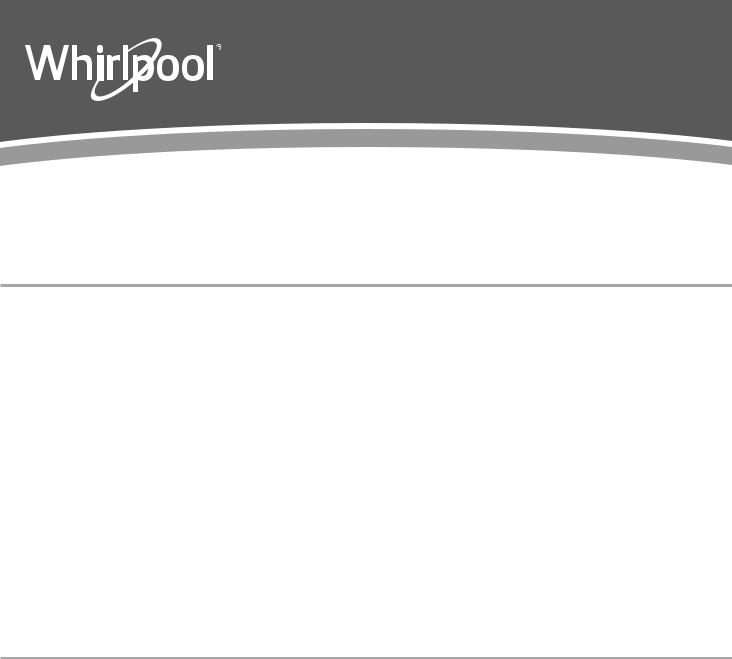
ELECTRIC RANGE
USER INSTRUCTIONS
THANK YOU for purchasing this high-quality product.
For future reference, please make a note of your product model and serial numbers. These can be found on the label located on the upper-right corner of the front frame.
Model Number________________________________________ |
|
|
|
Serial Number_________________________________________ |
|
TABLE OF CONTENTS |
|
|
RANGE SAFETY........................................................................... |
|
2 |
The Anti-Tip Bracket................................................................. |
|
2 |
FEATURE GUIDE......................................................................... |
|
4 |
COOKTOP USE............................................................................ |
|
6 |
Cookware.................................................................................. |
|
7 |
Home Canning.......................................................................... |
|
8 |
OVEN USE.................................................................................... |
|
9 |
Electronic Oven Controls........................................................... |
|
9 |
Sabbath Mode......................................................................... |
|
10 |
Keep Warm.............................................................................. |
|
10 |
Positioning Racks and Bakeware............................................ |
|
11 |
Oven Vent................................................................................ |
|
11 |
Baking and Roasting............................................................... |
|
11 |
Broiling.................................................................................... |
|
12 |
Cook Time............................................................................... |
|
12 |
RANGE CARE............................................................................ |
|
13 |
Self-Cleaning Cycle................................................................. |
|
13 |
General Cleaning..................................................................... |
|
14 |
Oven Light............................................................................... |
|
15 |
TROUBLESHOOTING................................................................ |
|
16 |
ASSISTANCE OR SERVICE....................................................... |
|
18 |
W11256526A
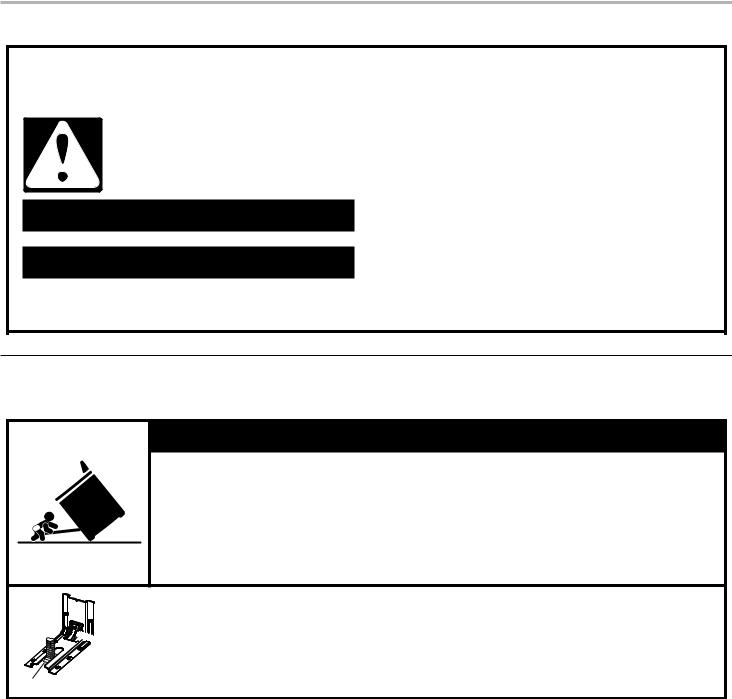
RANGE SAFETY
Your safety and the safety of others are very important.
many important safety messages in this manual and on your appliance. Always read and obey all safety
safety alert symbol.
alerts you to potential hazards that can kill or hurt you and others.
messages will follow the safety alert symbol and either the word “DANGER” or “WARNING.” mean:
 DANGER
DANGER  WARNING
WARNING
You can be killed or seriously injured if you don't immediately follow instructions.
You can be killed or seriously injured if you don't follow instructions.
All safety messages will tell you what the potential hazard is, tell you how to reduce the chance of injury, and tell you what can happen if the instructions are not followed.
The Anti-Tip Bracket
The range will not tip during normal use. However, the range can tip if you apply too much force or weight to the open door without the anti-tip bracket fastened down properly.
 WARNING
WARNING
Tip Over Hazard A child or adult can tip the range and be killed.
Verify the anti-tip bracket has been properly installed and engaged per installation instructions. Re-engage anti-tip bracket if range is moved.
Do not operate range without anti-tip bracket installed and engaged.
Failure to follow these instructions can result in death or serious burns to children and adults.
Anti-Tip



 Bracket
Bracket
Range Foot
To verify the anti-tip bracket is installed and engaged:
•Slide range forward.
•Look for the anti-tip bracket securely attached to floor or wall.
•Slide range back so rear range foot is under anti-tip bracket.
•See installation instructions for details.
2

IMPORTANT SAFETY INSTRUCTIONS
WARNING: To reduce the risk of fire, electrical shock, injury to persons, or damage when using the range, follow basic precautions, including the following:
■ WARNING: TO REDUCE THE RISK OF TIPPING OF THE RANGE, THE RANGE MUST BE SECURED BY PROPERLY INSTALLED ANTI-TIP DEVICES. TO CHECK IF THE DEVICES ARE INSTALLED PROPERLY, SLIDE RANGE FORWARD, LOOK FOR ANTI-TIP BRACKET SECURELY ATTACHED TO FLOOR OR WALL, AND SLIDE RANGE BACK SO REAR RANGE FOOT IS UNDER ANTI-TIP BRACKET.
■ CAUTION: Do not store items of interest to children in cabinets above a range or on the backguard of a range – children climbing on the range to reach items could be seriously injured.
■Proper Installation – Be sure the range is properly installed and grounded by a qualified technician.
■Never Use the Range for Warming or Heating the Room.
■Do Not Leave Children Alone – Children should not be left alone or unattended in area where the range is in use. They should never be allowed to sit or stand on any part of the range.
■Wear Proper Apparel – Loose-fitting or hanging garments should never be worn while using the range.
■User Servicing – Do not repair or replace any part of the range unless specifically recommended in the manual. All other servicing should be referred to a qualified technician.
■Storage in or on the Range – Flammable materials should not be stored in an oven or near surface units.
■Do Not Use Water on Grease Fires – Smother fire or flame or use dry chemical or foam-type extinguisher.
■Use Only Dry Potholders – Moist or damp potholders on hot surfaces may result in burns from steam. Do not let potholder touch hot heating elements. Do not use a towel or other bulky cloth.
■DO NOT TOUCH SURFACE UNITS OR AREAS NEAR UNITS – Surface units may be hot even though they are dark in color. Areas near surface units may become hot enough to cause burns. During and after use, do not touch, or let clothing or other flammable materials contact surface units or areas near units until they have had sufficient time to cool. Among those areas are the cooktop and surfaces facing the cooktop.
■Use Proper Pan Size – The range is equipped with one or more surface units of different size. Select utensils having flat bottoms large enough to cover the surface unit heating element. The use of undersized utensils will expose a portion of the heating element to direct contact and may result in ignition of clothing. Proper relationship of utensil to burner will also improve efficiency.
■Never Leave Surface Units Unattended at High Heat Settings – Boilover causes smoking and greasy spillovers that may ignite.
■Make Sure Reflector Pans or Drip Bowls Are in Place – Absence of these pans or bowls during cooking may subject wiring or components underneath to damage.
■Protective Liners – Do not use aluminum foil to line surface unit drip bowls or oven bottoms, except as suggested in the manual. Improper installation of these liners may result in a risk of electric shock, or fire.
■Glazed Cooking Utensils – Only certain types of glass, glass/ceramic, ceramic, earthenware, or other glazed utensils are suitable for range-top service without breaking due to the sudden change in temperature.
■Utensil Handles Should Be Turned Inward and Not Extend Over Adjacent Surface Units – To reduce the risk of burns, ignition of flammable materials, and spillage due to unintentional contact with the utensil, the handle of a utensil should be positioned so that it is turned inward, and does not extend over adjacent surface units.
■Do Not Soak Removable Heating Elements – Heating elements should never be immersed in water.
■Do Not Cook on Broken Cooktop – If cooktop should break, cleaning solutions and spillovers may penetrate the broken cooktop and create a risk of electric shock. Contact a qualified technician immediately.
■Clean Cooktop With Caution – If a wet sponge or cloth is used to wipe spills on a hot cooking area, be careful to avoid steam burn. Some cleaners can produce noxious fumes if applied to a hot surface.
■Use Care When Opening Door – Let hot air or steam escape before removing or replacing food.
■Do Not Heat Unopened Food Containers – Build-up of pressure may cause container to burst and result in injury.
■Keep Oven Vent Ducts Unobstructed.
■Placement of Oven Racks – Always place oven racks in desired location while oven is cool. If rack must be moved while oven is hot, do not let potholder contact hot heating element in oven.
■DO NOT TOUCH HEATING ELEMENTS OR INTERIOR SURFACES OF OVEN – Heating elements may be hot even though they are dark in color. Interior surfaces of an oven become hot enough to cause burns. During and after use, do not touch, or let clothing or other flammable materials contact heating elements or interior surfaces of oven until they have had sufficient time to cool. Other surfaces of the appliance may become hot enough to cause burns – among these surfaces are oven vent openings and surfaces near these openings, oven doors, and windows of oven doors.
For self-cleaning ranges –
■Do Not Clean Door Gasket – The door gasket is essential for a good seal. Care should be taken not to rub, damage, or move the gasket.
■Do Not Use Oven Cleaners – No commercial oven cleaner or oven liner protective coating of any kind should be used in or around any part of the oven.
■Clean Only Parts Listed in Manual.
■Before Self-Cleaning the Oven – Remove broiler pan and other utensils.
For units with ventilating hood –
■Clean Ventilating Hoods Frequently – Grease should not be allowed to accumulate on hood or filter.
■When flambeing foods under the hood, turn the fan on.
SAVE THESE INSTRUCTIONS
3

FEATURE GUIDE
This manual covers several models. Your model may have some or all of the items listed. Refer to this manual or the Frequently Asked Questions section of our website at www.whirlpool.com for more detailed instructions.
 WARNING
WARNING
Food Poisoning Hazard
Do not let food sit in oven more than one hour before or after cooking.
Doing so can result in food poisoning or sickness.
|
|
|
|
|
|
|
|
|
|
|
|
|
|
|
|
|
|
|
|
|
|
|
|
|
|
|
|
|
|
|
|
|
|
|
|
|
|
|
|
|
|
|
|
|
|
|
|
|
|
|
|
|
|
|
|
|
|
|
|
|
|
|
|
|
|
|
|
|
|
|
|
|
|
|
|
|
|
|
|
|
|
|
|
|
|
|
|
|
|
|
|
|
|
|
|
|
|
|
|
|
|
|
|
|
|
|
|
|
|
|
|
|
|
|
|
|
|
|
|
|
|
|
|
|
|
|
|
|
|
|
|
|
|
|
|
|
|
|
|
|
|
|
|
|
|
|
|
|
|
|
|
|
|
KEYPAD |
|
FEATURE |
INSTRUCTIONS |
||||||||||
|
|
|
|
||||||||||
CLOCK |
|
Clock |
The Clock uses a 12-hour cycle. |
||||||||||
|
|
|
1. |
Check that the oven is OFF. |
|||||||||
|
|
|
2. |
Press CLOCK. |
|||||||||
|
|
|
3. |
Press Temp/Time “up” or “down” arrow keypad to set the hours. Press CLOCK to |
|||||||||
|
|
|
|
|
switch to the minutes. Press Temp/Time “up” or “down” arrow keypad to set the |
||||||||
|
|
|
|
|
minutes. |
||||||||
|
|
|
4. |
Press CLOCK or START. |
|||||||||
LIGHT |
Oven cavity light |
TIMER SET/OFF |
Oven timer |
START |
Cooking start |
CANCEL |
Range function |
TEMP/TIME |
Temperature and |
|
time adjust |
BAKE |
Baking and |
|
roasting |
While the oven door is closed, press LIGHT to turn the light on and off. The oven light will come on when the oven door is opened. The oven light will not come on during the SelfCleaning cycle.
The Timer can be set in hours or minutes up to 9 hours and 59 minutes.
1.Press TIMER SET/OFF.
2.Press Temp/Time “up” or “down” arrow keypad to set the length of time.
3.Press START to begin the countdown. If enabled, end-of-cycle tones will sound at end of countdown.
4.Press TIMER SET/OFF to cancel the Timer. Do not press CANCEL because the oven will turn off.
The Start keypad begins any oven function. If Start is not pressed within 10 seconds, a tone will sound and Start will blink until pressed or canceled. If Start is not pressed
within 30 seconds after pressing a keypad, the function is canceled and the time of day is displayed.
The Cancel keypad stops any function except the Timer and Oven Control Lockout.
The Temp/Time “up” and “down” arrow keypads are used to adjust time and temperature settings.
1.Press BAKE.
2.Press Temp/Time “up” or “down” arrow keypad until desired temperature is reached. A tone will sound if the minimum or maximum temperature is reached.
3.Press START.
4.To change the temperature, repeat Step 2. Press START.
5.Press CANCEL when finished.
|
|
NOTE: The convection fan will shut off when the oven door is opened. If the oven door |
|
|
remains open for too long, the heating elements will shut off until the oven door is closed. |
|
|
All timers, including any active Cook Time or Timed Cook functions, will continue to count |
|
|
down. |
CLEAN |
Self-Cleaning |
See the “Self-Cleaning Cycle” section. |
(on some models) |
cycle |
|
4

KEYPAD |
FEATURE |
INSTRUCTIONS |
|
|
|
|
|
FROZEN BAKE |
Prepackaged |
1. |
Position the food on a flat rack in the oven on rack position 3. See the “Positioning |
|
food |
|
Racks and Bakeware” section. |
|
|
|
NOTE: Cook only 1 package of frozen food at a time when using Frozen Bake™ |
|
|
|
Technology. |
|
|
2. |
Press FROZEN BAKE LASAGNA or PIZZA. |
|
|
3. |
Press the Temp/Time “up” or “down” arrow keypad to set the temperature as |
|
|
|
recommended on the food packaging. |
|
|
4. |
Press COOK TIME. |
BROIL Broiling
KEEP WARM |
Hold warm |
DELAY |
Delayed start |
COOK TIME |
Timed cooking |
CONTROL LOCK |
Oven and |
hold 3 sec |
cooktop control |
|
lockout |
5.Press the Temp/Time “up” or “down” arrow keypad to set the maximum cook time as recommended on the food packaging.
6.Press START. The range will calculate the best cook time based on the current oven temperature.
NOTE: The cook time that appears in the display is the estimated required cook time as calculated by the oven control. It may be different than the time you entered. A beep will alert you to check the food’s doneness with at least 2 minutes remaining on the timer. To add more time, press the “up” arrow keypad and press START. The time entered is added to the remaining time
7.Press START to start the calculated time.
8.At the end of the cook time, a beep will alert you to check the food’s doneness. To add more time, press the “up” arrow keypad and press START. Unless more time is selected, the bake element turns off.
9.Press CANCEL when finished.
NOTE: The convection fan will shut off when the oven door is opened. If the oven door remains open for too long, the heating elements will shut off until the oven door is closed. All timers, including any active Cook Time or Timed Cook functions, will continue to count down.
1.Position cookware in oven and close the oven door.
2.Press BROIL.
3.Press Temp/Time “up” or “down” arrow keypad until the desired temperature is reached. A tone will sound if the minimum or maximum temperature is reached.
4.Press START.
5.To change the temperature, repeat Step 3. Press START.
6.Press CANCEL when finished.
NOTE: The convection fan will shut off when the oven door is opened. If the oven door remains open for too long, the heating elements will shut off until the oven door is closed. All timers, including any active Cook Time or Timed Cook functions, will continue to count down.
Food must be at serving temperature before placing it in the warmed oven.
1.Press KEEP WARM.
2.Temperature is set at 170°F (75°C). Press the Temp/Time “up” or “down” arrow keypad until desired temperature is reached. A tone will sound if the minimum or maximum temperature is reached.
3.Press START.
4.Press CANCEL when finished.
NOTE: The convection fan will shut off when the oven door is opened. If the oven door remains open for too long, the heating elements will shut off until the oven door is closed. All timers, including any active Cook Time or Timed Cook functions, will continue to count down.
The Delay keypad is used to enter the starting time for an oven function with a delayed start. Delay should not be used for foods such as breads and cakes because they may not bake properly.
To set a Timed Cook or a Delayed Timed Cook, see “Cook Time” section.
Cook Time allows the oven to be set to turn on at a certain time of day, cook for a set length of time, and/or shut off automatically.
To set a Timed Cook or a Delayed Timed Cook, see “Cook Time” section.
1.Check that the oven and cooktop are off.
2.Press and hold CONTROL LOCK for 3 seconds.
3.A tone will sound and a lock will be displayed.
4.Repeat to unlock. No keypad will function with the controls locked.
NOTE: The control lock cannot be activated or deactivated while the Hot Surface indicator light is on. Wait for the Hot Surface indicator light to turn off before activating or deactivating the control lock.
5
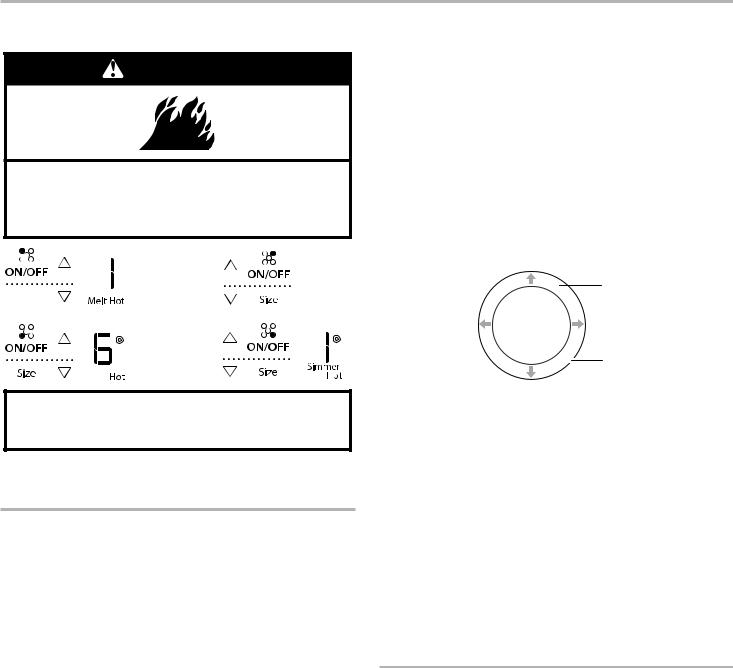
COOKTOP USE
ARNING
Fire Hazard
Turn off all controls when done cooking. Failure to do so can result in death or fire.
■■ To avoid scratches, do not slide cookware or bakeware across the cooktop. Aluminum or copper bottoms and rough finishes on cookware or bakeware could leave scratches or marks on the cooktop.
■■ Do not cook popcorn in prepackaged aluminum containers on the cooktop. They could leave aluminum marks that cannot be removed completely.
■■ To avoid damage to the cooktop, do not allow objects that could melt, such as plastic or aluminum foil, to touch any part of the entire cooktop.
■■ To avoid damage to the cooktop, do not use the cooktop as a cutting board.
■■ Use cookware about the same size as the surface cooking area. Cookware should not extend more than 1/2" (1.3 cm) outside the area.
B
A
C
REMEMBER: When range is in use or (on some models) during the Self-Cleaning cycle, the entire cooktop area may become hot.
IMPORTANT: When cooktop is in use, the Self-Cleaning cycle will be disabled. When the Self-Cleaning cycle is in use, the cooktop will be locked.
Ceramic Glass (on some models)
The surface cooking area will glow red when an element is ON. Some parts of the surface cooking area may not glow red when an element is ON. This is normal operation. It will also randomly cycle off and back on again, even while on High, to keep the cooktop from extreme temperatures.
It is normal for the surface of light colored ceramic glass to appear to change color when surface cooking areas are hot. As the glass cools, it will return to its original color.
Clean the cooktop after each use to help avoid scratches, pitting, abrasions and to condition the glass surface. Ceramic glass cooktop cleaner and a cooktop scraper are also recommended for stubborn soils. Do not use abrasive cleaners, cleaning pads, or harsh chemicals for cleaning. Refer to the “Range Care” section for additional information.
IMPORTANT: To avoid permanent damage to the cooktop surface and to make soils easier to remove, clean the cooktop after each use to remove all soils.
■■ Avoid storing jars or cans above the cooktop. Dropping a heavy or hard object onto the cooktop could crack the cooktop.
■■ To avoid damage to the cooktop, do not leave a hot lid on the cooktop. As the cooktop cools, air can become trapped between the lid and the cooktop and the ceramic glass could break when the lid is removed.
■■ For foods containing sugar in any form, clean up all spills and soils as soon as possible. Allow the cooktop to cool down slightly. Then, while wearing oven mitts, remove the spills using a scraper while the surface is still warm. If sugary spills are allowed to cool down, they can adhere to the cooktop and can cause pitting and permanent marks.
A.Surface cooking area
B.Cookware/canner
C.1/2" (1.3 cm) maximum overhang
■■ Use flat-bottomed cookware for best heat conduction and energy efficiency. Cookware with rounded, warped, ribbed, or dented bottoms could cause uneven heating and poor cooking results.
■■ Determine flatness by placing the straight edge of a ruler across the bottom of the cookware. While you rotate the ruler, no space or light should be visible between it and the cookware.
■■ Cookware designed with slightly indented bottoms or small expansion channels can be used.
■■ Make sure the bottoms of pots and pans are clean and dry before using them. Residue and water can leave deposits when heated.
■■ To avoid damage to the cooktop, do not cook foods directly on the cooktop.
Ceramic Glass Cooktop Cleaning (on some models)
Clean the cooktop after each use to help avoid scratches, pitting, abrasions and to condition the glass surface. Ceramic glass cooktop cleaner and a cooktop scraper are also recommended for stubborn soils. Do not use abrasive cleaners, cleaning pads, or harsh chemicals for cleaning. Refer to the “Range Care” section for additional information.
IMPORTANT: To avoid permanent damage to the cooktop surface and to make soils easier to remove, clean the cooktop after each use to remove all soils.
6
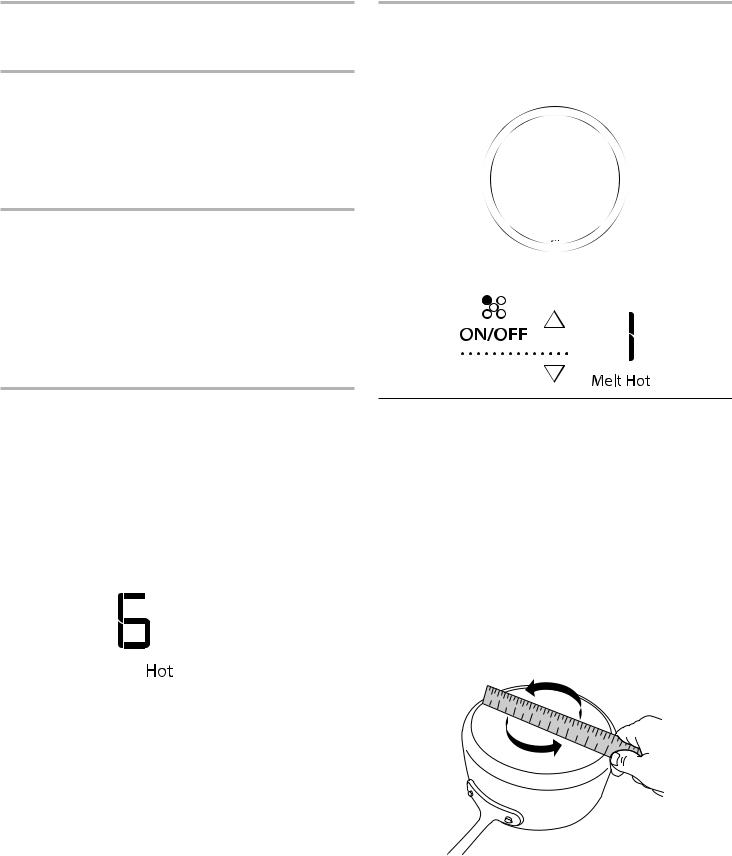
Cooktop On Indicator Light
The Cooktop On indicator light is located on the display panel. When any cooktop element on the console panel is turned on, the Cooktop On indicator light will glow.
Hot Surface Indicator Light
On ceramic glass models, the Hot Surface indicator light is located on the display panel.
The Hot Surface indicator light will glow as long as any surface cooking area is too hot to touch, even after the surface cooking area is turned off.
The control lock cannot be turned on or off while the Hot Surface indicator light is on. Wait for the Hot Surface indicator light to turn off before turning the control lock on or off.
Coil Elements and Burner Bowls (on some models)
Coil elements should be level for optimal cooking results. Burner bowls, when clean, reflect heat back to the cookware. They also help catch spills.
Cookware should not extend more than 1/2" (1.3 cm) over the coil element. If cookware is uneven or too large, it can produce excess heat, causing the burner bowl to change color.
■■ Starting in June 2018 Whirlpool is equipping this product with new temperature-limiting coils pursuant to the updated standards in UL858. These new coils may vary cooking times compared to your old cooktop, e.g., a slightly longer time to boil large volumes of water.
Dual Zone Cooking Element (on some models)
The Dual Zone Cooking Element offers flexibility depending on the size of the cookware. Single size can be used in the same way as a regular element. The dual size combines both the single and outer elements and is recommended for larger size cookware.
1.Press ON/OFF for the desired Dual Zone element.
2.Press SIZE to select dual element and a picture of the dual element will appear.
3.Press the “up” and “down” element arrow keypads to adjust the heating element to the desired level.
4.To switch back to the single element, press SIZE.
5.Press ON/OFF for the selected element to turn the element off.

 A
A
A. Dual cooking element
Melt Cooking Element
The Melt cooking element offers flexibility due to a wide range of settings between High and Melt. The High heat option can be used to boil small amounts of liquid quickly. The lowest setting can be used to prepare sauces and to keep foods at a low temperature. Use cookware appropriate in size for the Melt element.
To reduce the power setting to Melt, press the “down” arrow for the Melt element until “Melt” appears in the display.
Cookware
IMPORTANT: Do not leave empty cookware on a hot surface cooking area, element, or surface burner.
Ideal cookware should have a flat bottom, straight sides, and a well-fitting lid, and the material should be of medium-to-heavy thickness.
Rough finishes may scratch the cooktop. Aluminum and copper may be used as a core or base in cookware. However, when used as a base, they can leave permanent marks on the surfaces.
Cookware material is a factor in how quickly and evenly heat is transferred which affects cooking results. A nonstick finish has the same characteristics as its base material. For example, aluminum cookware with a nonstick finish will take on the properties of aluminum.
Cookware with nonstick surfaces should not be used under the broiler.
Check for flatness by placing the straight edge of a ruler across the bottom of the cookware. While you rotate the ruler, no space or light should be visible between it and the cookware.
1 2
|
3 |
1 |
4 |
5 |
6 2
2 |
1 3 |
|
|
|
|
|
|
|
|
5 |
1 |
4 |
|
|
|
|
1 5 |
|
|
|
|
6 |
1 |
6 |
|
|
|
1 7 |
|
1 8 |
|
7 |
1 |
9 |
|
|
2 0 |
7

Use the following chart as a guide for cookware material characteristics.
COOKWARE |
CHARACTERISTICS |
||
Aluminum |
■■ |
Heats quickly and evenly. |
|
|
■■ Suitable for all types of cooking. |
||
|
■■ Medium or heavy thickness is best for |
||
|
|
most cooking tasks. |
|
|
■■ May leave aluminum residues |
||
|
|
which may be diminished if cleaned |
|
|
|
immediately after cooking. |
|
|
|
|
|
Cast iron |
■■ |
Heats slowly and evenly. |
|
|
■■ Good for browning and frying. |
||
|
■■ Maintains heat for slow cooking. |
||
|
■■ Rough edges or burrs may scratch |
||
|
|
the cooktop. |
|
|
|
|
|
Ceramic or |
■■ |
Follow manufacturer’s instructions. |
|
Ceramic glass |
■■ |
Heats slowly, but unevenly. |
|
|
|||
|
■■ Ideal results on low-to-medium heat |
||
|
|
settings. |
|
|
■■ May scratch the cooktop. |
||
|
|
|
|
Copper |
■■ |
Heats very quickly and evenly. |
|
|
■■ May leave copper residues which may |
||
|
|
be diminished if cleaned immediately |
|
|
|
after cooking. |
|
|
■■ Can leave a permanent stain or bond |
||
|
|
to the cooktop if overheated. |
|
|
|
|
|
Earthenware |
■■ |
Follow manufacturer’s instructions. |
|
|
■■ Use on low heat settings. |
||
|
■■ May scratch the cooktop. |
||
|
|
|
|
Porcelain |
■■ |
See stainless steel or cast iron. |
|
enamel-on- |
■■ |
Porcelain enamel bakeware without |
|
steel or cast |
|||
|
the metal base may bond to the |
||
iron |
|
||
|
cooktop if overheated. |
||
|
|
||
|
|
|
|
Stainless steel |
■■ |
Heats quickly, but unevenly. |
|
|
■■ A core or base of aluminum or copper |
||
|
|
on stainless steel provides even |
|
|
|
heating. |
|
|
|
|
|
Use flat-bottomed cookware for best cooking results and energy efficiency. The cookware should be about the same size as the cooking area outlined on the cooktop. Cookware should not extend more than 1/2" (1.3 cm) outside the area.
Home Canning
Canning can be performed on a glass smooth-top cooking surface or traditional coil element cooktop. When canning for long periods, alternate the use of surface cooking areas or elements between batches. This allows time for the most recently used areas to cool.
■■ Center the canner on the largest surface cooking area or element. On electric cooktops, canners should not extend more than 1/2" (1.3 cm) beyond the surface cooking area or element.
■■ Do not place canner on 2 surface cooking areas or elements at the same time.
■■ On ceramic glass models, use only flat-bottomed canners to avoid damage to the cooktop and elements.
■■ For more information, contact your local agricultural extension office or refer to published home canning guides. Companies that manufacture home canning products can also offer assistance.
8

OVEN USE
Odors and smoke are normal when the oven is used the first few times or when it is heavily soiled.
IMPORTANT: The health of some birds is extremely sensitive to the fumes given off. Exposure to the fumes may result in death to certain birds. Always move birds to another closed and well-ventilated room.
NOTE: The convection fan will shut off when the oven door is opened. If the oven door remains open for too long, the heating elements will shut off until the oven door is closed. All timers, including any active Cook Time or Timed Cook functions, will continue to count down.
Electronic Oven Controls
Control Display
The display will flash when powered up or after a power loss. Press CANCEL to clear. When oven is not in use, the time of day is displayed.
Fahrenheit and Celsius
The temperature is preset to Fahrenheit but can be changed to Celsius.
To change: Press and hold the Temp/Time “up” arrow keypad for 5 seconds. “°C” or “°F” will appear on the display. Repeat to change back.
To exit mode, press CANCEL.
Keypress Tones
Activates or turns off the tones when a keypad is pressed.
To change: Press and hold LIGHT for 5 seconds. Repeat to change back.
To exit mode, press CANCEL.
Demo Mode
IMPORTANT: This feature is intended for use on the sales floor with 120 V power connection and permits the control features to be demonstrated without heating elements turning on. If this feature is activated, the oven will not work.
To change: Press CANCEL, CANCEL, Temp/Time “up” arrow keypad, TIMER SET/OFF. Repeat to change back and end Demo mode.
Tones
Tones are audible signals, indicating the following:
Basic Functions
One Tone
■■ Valid keypad press
■■ Oven is preheated (long tone) ■■ Function has been entered
■■ Reminder, repeating every 20 seconds after the end-of-cycle tones
Three Tones
■■ Invalid keypad press
Four Tones
■■ End of cycle
Oven Temperature Control
IMPORTANT: Do not use a thermometer to measure oven temperature. Elements will cycle on and off as needed to provide consistent temperature but may run slightly hot or cool at any point in time due to this cycling. Most thermometers are slow
to react to temperature change and will not provide an accurate reading due to this cycling.
The oven provides accurate temperatures; however, it may cook faster or slower than your previous oven, so the temperature can be adjusted to personalize it for your cooking needs. It can be changed in Fahrenheit or Celsius.
To Adjust Oven Temperature:
1.Press and hold the Temp/Time “down” arrow keypad for
5 seconds until the oven display shows the current setting, for example “0°F CAL” or “00.”
2.Press the Temp/Time “up” or “down” arrow keypad to increase or to decrease the temperature in 5°F (3°C) amounts. The adjustment can be set between 30°F (18°C) and -30°F (-18°C).
3.Press START.
9
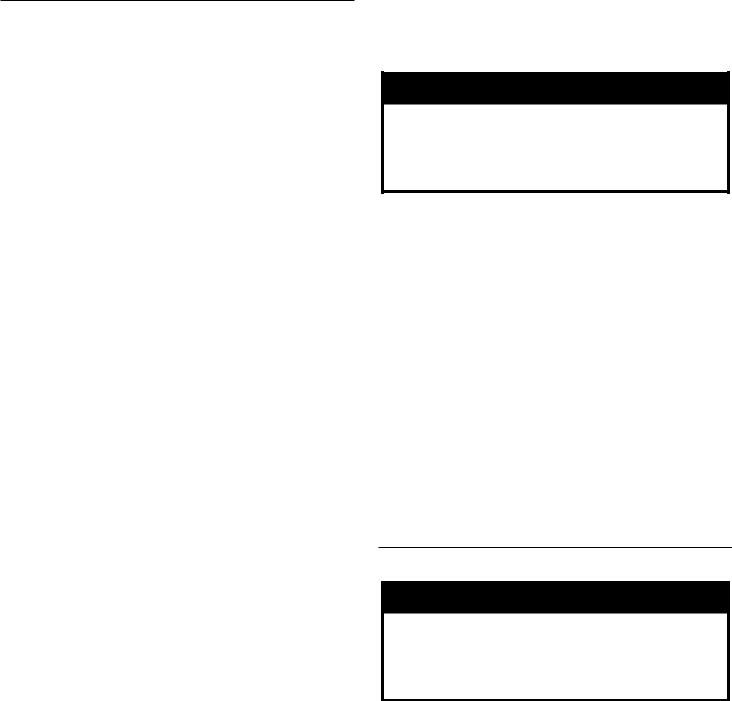
Sabbath Mode
(on some models)
The Sabbath mode sets the oven to remain on in a Bake setting until turned off. A Timed Bake can also be set to keep the oven on for only part of the Sabbath. The Oven Control Lockout feature (if present) will be disabled during the Sabbath mode. After the Sabbath mode is set, no tones will sound, the display will not show the temperature, the Kitchen Timer mode will be canceled (if active), and only the following keypads will function:
■■ Temp/Time “up” and “down” arrow keypads
■■ Cancel
When the oven door is opened or closed, the oven light will not turn on or off and the heating elements will not turn on or off immediately.
When power is restored after a power failure, the oven will return to Sabbath mode and remain Sabbath compliant with the bake elements off until the Cancel keypad is pressed.
Pressing the Cancel keypad at any time cancels the cooking cycle and returns the oven to the normal cooking mode (not Sabbath compliant).
Before entering the Sabbath mode, it must be decided if the oven light is to be ON or OFF for the entire Sabbath mode period. If the light is ON when entering Sabbath mode, it will remain ON for the entire time Sabbath mode is in use. If the light is OFF when entering Sabbath mode, it will remain OFF for the entire time Sabbath mode is in use. Opening the oven door or pressing the Light keypad will not affect the oven light once Sabbath mode has been entered.
On the Holiday, the oven temperature can be changed once the oven is in Sabbath mode by pressing the Temp/Time “up” or “down” arrow keypad. The oven temperature will change 25°F (14°C) each time the Temp/Time “up” and “down” arrow keypads are pressed. Press START to activate the new temperature. The display will not change and there will be no sounds during this adjustment.
To Bake Using Sabbath Mode:
1.Press BAKE.
2.To change the temperature, press the Temp/Time “up” or “down” arrow keypad.
3.Press START.
4.Press and hold the Timer Set/Off keypad for 5 seconds. “SAb” will flash in the display.
5.Press START while “SAb” is flashing to enter Sabbath mode; otherwise, the entire cycle cancels out. “SAb” will stop flashing and remain on in the display. The oven is now in Sabbath mode and is Sabbath compliant.
Pressing the Cancel keypad at any time cancels the cooking cycle and returns the oven to the normal cooking mode (not Sabbath compliant).
To Set a Timed Bake Using Sabbath Mode (on some models):
1.Press BAKE.
2.Press the Temp/Time “up” or “down” arrow keypad to enter a temperature other than the one displayed.
3.Press COOK TIME. The Cook Time oven indicator light will light up.
4.Press the Temp/Time “up” or “down” arrow keypad to enter a cook time length.
5.Press START.
6.Press and hold the Timer Set/Off keypad for 5 seconds. “SAb” will flash in the display.
7.Press START while “SAb” is flashing to enter Sabbath mode; otherwise, the entire cycle cancels out. “SAb” will stop flashing and remain on in the display. The oven is now in Sabbath mode and is Sabbath compliant. The Bake, On, and Cook Time indicator lights will be displayed.
When the set cook time ends, the oven will shut off automatically and the indicator lights will turn off, indicating the end of the cycle.
Pressing the Cancel keypad at any time cancels the cooking cycle and returns the oven to the normal cooking mode (not Sabbath mode compliant).
To Set a Delayed Timed Bake Using Sabbath Mode (on some models):
 WARNING
WARNING
Food Poisoning Hazard
Do not let food sit in oven more than one hour before or after cooking.
Doing so can result in food poisoning or sickness.
1.Press BAKE.
2.Press the Temp/Time “up” or “down” arrow keypad to enter a temperature other than the one displayed.
3.Press COOK TIME. The Cook Time oven indicator light will light up.
4.Press the Temp/Time “up” or “down” arrow keypad to enter a cook time length.
5.Press DELAY. The Delay indicator light will light up.
6.Press the Temp/Time “up” or “down” arrow keypad to enter a start time.
7.Press START.
8.Press and hold the Timer Set/Off keypad for 5 seconds. “SAb” will flash in the display.
9.Press START while “SAb” is flashing to enter Sabbath mode; otherwise, the entire cycle cancels out. “SAb” will stop flashing and remain on in the display. The oven is now in Sabbath mode and is Sabbath compliant. The Delay indicator light will be displayed.
When the start time is reached the Bake, On, and Cook Time indicator lights will automatically turn on. When the set cook time ends, the oven will shut off automatically and the indicator lights will turn off, indicating the end of the cycle.
Pressing the Cancel keypad at any time returns the oven to the normal cooking mode (not Sabbath mode compliant).
Keep Warm
 WARNING
WARNING
Food Poisoning Hazard
Do not let food sit in oven more than one hour before or after cooking.
Doing so can result in food poisoning or sickness.
NOTE: The convection fan will shut off when the oven door is opened. If the oven door remains open for too long, the heating elements will shut off until the oven door is closed. All timers, including any active Cook Time or Timed Cook functions, will continue to count down.
IMPORTANT: Food must be at serving temperature before placing it in the warmed oven. Food may be held up to 1 hour; however, breads and casseroles may become too dry if left in the oven during the Keep Warm function. For best results, cover food.
The Keep Warm feature allows hot cooked foods to stay at serving temperature.
To Use:
1.Press WARM.
2.Press Temp/Time “up” or “down” arrow keypad until desired temperature is reached. A tone will sound if the minimum or maximum temperature is reached.
3.Press START.
4.Place food in the oven.
10
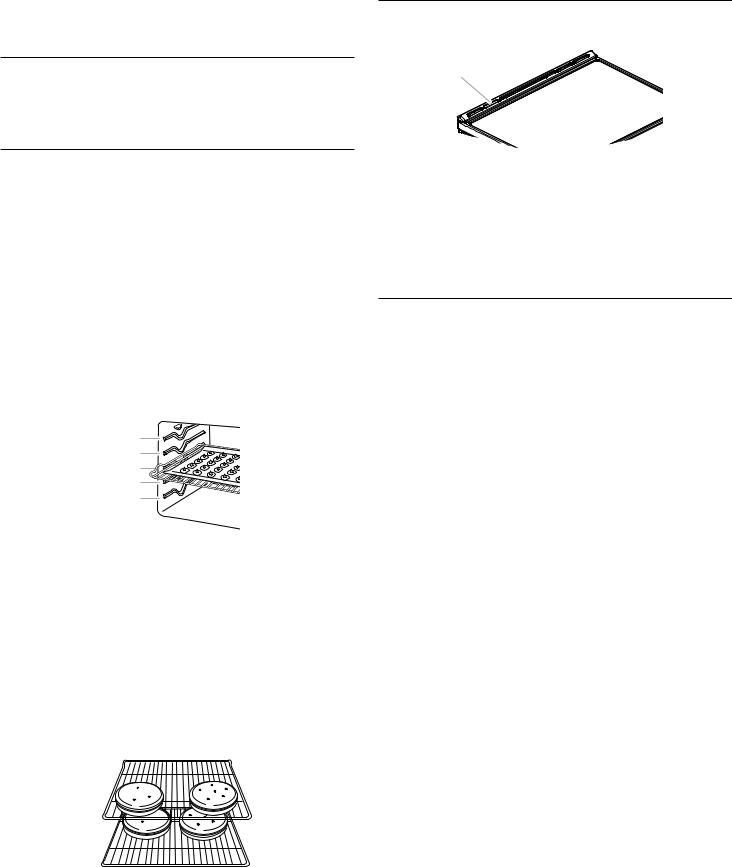
5. Press CANCEL when finished.
NOTE: The temperature may be changed at any time by pressing the Temp/Time “up” or “down” arrow keypad to the desired temperature and then START.
Aluminum Foil
IMPORTANT: To avoid permanent damage to the oven bottom finish, do not line the oven bottom with any type of foil or liner.
For best cooking results, do not cover entire oven rack with foil because air must be able to move freely.
Positioning Racks and Bakeware
IMPORTANT: To avoid permanent damage to the porcelain finish, do not place food or bakeware directly on the oven door or bottom.
Bakeware
To cook food evenly, hot air must be able to circulate. Allow
2" (5 cm) of space around bakeware and oven walls. Make sure that no bakeware piece is directly over another.
Racks
■■ Position racks before turning on the oven.
■■ Do not position racks with bakeware on them.
■■ Make sure racks are level.
To move a rack, pull it out to the stop position, raise the front edge, and then lift out. Use the following illustration as a guide.
5
4
3
2
1
Rack Positions
Rack 5: Toasting bread or broiling thin, non-fatty foods Rack 4: 2-rack baking and broiling
Rack 3: Most baked goods on a cookie sheet, muffin pan, or jelly roll pan; layer cakes; broiling chicken pieces
Rack 2: Pies, casseroles, yeast bread, quick breads, frozen convenience foods, 2-rack baking
Rack 1: Roasting large and small cuts of meat and poultry
Multiple Rack Cooking
2-rack: Use rack positions 2 and 4.
Baking Layer Cakes on 2 Racks
For best results when baking cakes on 2 racks, use racks 2 and 4 for baking. Place the cakes on the racks as shown.
Oven Vent
A
A. Oven vent
The oven vent releases hot air and moisture from the oven
and should not be blocked or covered. Blocking or covering the oven vent will cause poor air circulation, affecting cooking and cleaning results. Do not set plastics, paper, or other items that could melt or burn near the oven vent.
On coil element models, the element can be used when the oven is in use as long as the cookware does not extend more than 1/2" (1.3 cm) over the element.
Baking and Roasting
NOTE: The convection fan will shut off when the oven door is opened. If the oven door remains open for too long, the heating elements will shut off until the oven door is closed. All timers, including any active Cook Time or Timed Cook functions, will
continue to count down.
ACCUBAKE® Temperature Management System
The ACCUBAKE® system electronically regulates the oven heat levels during preheat and Bake to maintain a precise temperature range for optimal cooking results. The bake and broil elements or burners cycle on and off in intervals. On convection range models, the fan will run while preheating and may be cycled on and off for short intervals during Bake to provide the best results. This feature is automatically activated when the oven is in use.
Before baking and roasting, position racks according to “Positioning Racks and Bakeware” section. When roasting, it is not necessary to wait for the oven preheat cycle to end before putting food in unless it is recommended in the recipe.
Preheating
When Start is pressed, the oven will begin preheating. Once 100ºF (38ºC) is reached, the display temperature will increase as the actual temperature of the oven increases. When the preheat temperature is reached, a tone will sound and the selected temperature will appear on the display.
11

Broiling
NOTE: The convection fan will shut off when the oven door is opened. If the oven door remains open for too long, the heating elements will shut off until the oven door is closed. All timers, including any active Cook Time or Timed Cook functions, will continue to count down.
IMPORTANT: Close the door to ensure proper broiling temperature.
Changing the temperature when Custom Broiling allows more precise control when cooking. The lower the broil setting is, the slower the cooking. Thicker cuts and unevenly shaped pieces of meat, fish, and poultry may cook better at lower broil settings. Use rack 4 or 5 for broiling. Refer to the “Positioning Racks and Bakeware” section for more information.
On lower settings, the broil element will cycle on and off to maintain the proper temperature.
■■ For best results, use a broiler pan and grid. It is designed to drain juices and help avoid spatter and smoke.
NOTE: Odors and smoke are normal the first few times the oven is used or if the oven is heavily soiled.
Cook Time
 WARNING
WARNING
Food Poisoning Hazard
Do not let food sit in oven more than one hour before or after cooking.
Doing so can result in food poisoning or sickness.
To Set a Timed Cook:
1.Press BAKE. The Bake indicator light will light up.
2.Press the Temp/Time “up” or “down” arrow keypad to enter a temperature other than the one displayed.
3.Press COOK TIME. The cook time oven indicator light will light up.
4.Press the Temp/Time “up” or “down” arrow keypad to enter the length of time to cook.
5.Press START. The display will count down the time. When the time ends, the oven will shut off automatically.
6.Press CANCEL to clear the display.
To Set a Delayed Timed Cook:
Before setting, make sure the clock is set to the correct time of day. See the “Clock” keypad feature in the “Feature Guide” section.
1.Press BAKE.
2.Press the Temp/Time “up” or “down” arrow keypad to enter a temperature other than the one displayed.
3.Press COOK TIME. The cook time oven indicator light will light up.
4.Press Temp/Time “up” or “down” arrow keypad to enter the length of time to cook.
5.Press DELAY. The delay oven indicator light will light up.
6.Press Temp/Time “up” or “down” arrow keypad to enter the time of day to start.
7.Press START.
When the start time is reached, the oven will automatically turn on. The Temperature and/or Cook Time settings can be changed anytime after the oven turns ON by repeating steps 2-4 and pressing Start. To change to a different delay time, cancel the feature and repeat steps 1-7. When the set cook time ends, the oven will shut off automatically.
8. Press CANCEL to clear the display.
12
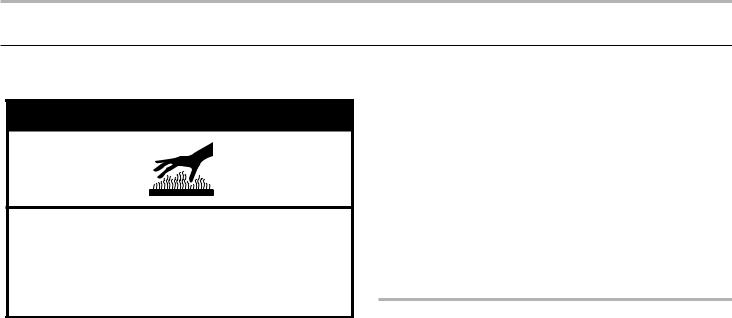
RANGE CARE
Self-Cleaning Cycle
(on some models)
 WARNING
WARNING
Burn Hazard
Do not touch the oven during the Self-Cleaning cycle.
Keep children away from oven during Self-Cleaning cycle.
Failure to follow these instructions can result in burns.
IMPORTANT: The health of some birds is extremely sensitive to the fumes given off during the Self-Cleaning cycle. Exposure to the fumes may result in death to certain birds. Always move birds to another closed and well-ventilated room.
Do not block the oven vent during the Self-Cleaning cycle. Air must be able to move freely. Depending on your model, see “Oven Vent” section.
Do not clean, rub, damage, or move the oven door gasket.
Prepare Range
■■ Remove the broiler pan, grid, cookware and bakeware, all cooking utensils, oven racks and aluminum foil and, on some models, the temperature probe from the oven.
■■ Use a damp cloth to clean inside door edge and the 11/2" (3.8 cm) area around the inside oven cavity frame, being certain not to move or bend the gasket.
■■ Remove plastic items from the cooktop because they may melt.
■■ Remove all items from the storage drawer.
How the Cycle Works
IMPORTANT: The heating and cooling of porcelain on steel in the oven may result in discoloring, loss of gloss, hairline cracks, and popping sounds.
Before Self-Cleaning, make sure the door is completely closed or the door will not lock and the Self-Cleaning cycle will not begin.
Once the oven has completely cooled, remove ash with a damp cloth. To avoid breaking the glass, do not apply a cool damp cloth to the inner door glass before it has completely cooled.
To stop the Self-Cleaning cycle at any time, press CANCEL.
If the temperature is too high, the oven door will remain locked and “cool” and “locked” will be displayed. The cooling fan may continue to run.
The oven light will not function during the Self-Cleaning cycle.
Electronic Oven Control with Adjustable Clean Time (on some models)
The Self-Cleaning cycle is time adjustable between 2 hours 30 minutes and 4 hours 30 minutes in 30-minute increments.
Suggested clean times are 2 hours 30 minutes for light soil, and 4 hours 30 minutes for heavy soil.
IMPORTANT: When cooktop is in use, the Self-Cleaning cycle will be disabled. When the Self-Cleaning cycle is in use, the cooktop will be locked.
To Self-Clean:
1.Press CLEAN.
2.Press the Temp/Time “up” or “down” arrow keypad to enter the desired Self-Cleaning cycle time.
3.Press START.
The oven door will automatically lock. The Door Locked and Clean indicator lights will be displayed. The time remaining will also be displayed.
4.When the Self-Cleaning cycle is complete and the oven cools, the Door Locked and Clean indicator lights will turn off.
5.When the oven is completely cooled, remove ash with a damp cloth.
To exit the Self-Cleaning cycle before completed, press CANCEL. The door will unlock once the oven cools.
13
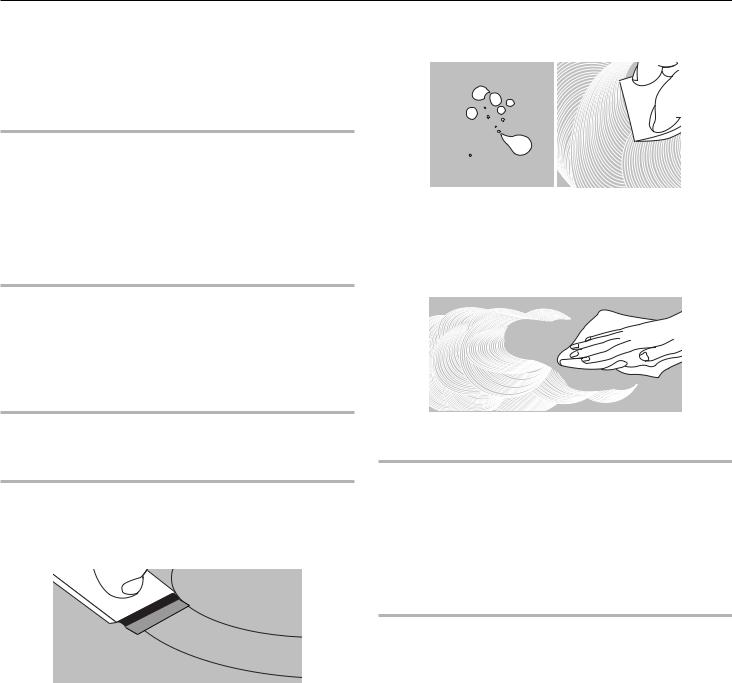
General Cleaning
IMPORTANT: Before cleaning, make sure all controls are OFF and the oven and cooktop are cool. Always follow label instructions on cleaning products. For additional information, you can visit
the Frequently Asked Questions (FAQs) section of our website at www.whirlpool.com.
Soap, water, and a soft cloth or sponge are suggested first unless otherwise noted.
EXTERIOR PORCELAIN ENAMEL SURFACES (on some models)
Food spills containing acids, such as vinegar and tomato, should be cleaned as soon as the entire range is cool. These spills may affect the finish.
Cleaning Method:
■■ Glass cleaner, mild liquid cleaner, or nonabrasive scrubbing pad:
Gently clean around the model/serial/rating plate because scrubbing may remove numbers.
STAINLESS STEEL (on some models)
NOTE: To avoid damage to stainless steel surfaces, do not use soap-filled scouring pads, abrasive cleaners, Cooktop Cleaner, steel-wool pads, gritty washcloths, or abrasive paper towels.
Damage may occur to stainless steel surfaces, even with onetime or limited use.
Cleaning Method:
Rub in direction of grain to avoid damaging.
METALLIC PAINT (on some models)
Do not use abrasive cleaners, cleaners with bleach, rust removers, ammonia, or sodium hydroxide (lye) because paint surface may stain.
CERAMIC GLASS (on some models)
Cleaning Method:
To avoid damaging the cooktop, do not use steel wool, abrasive powder cleansers, chlorine bleach, rust remover, or ammonia.
1. Remove food/residue with the Cooktop Scraper.
■■ For best results, use the Cooktop Scraper while the cooktop is still warm but not hot to the touch. It is recommended to wear an oven mitt while scraping the warm cooktop.
■■ Hold the Cooktop Scraper at approximately a 45° angle against the glass surface and scrape the residue. It will be necessary to apply pressure in order to remove the residue.
Allow the cooktop to cool down completely before proceeding to Step 2.
2.Apply a few dime-sized drops of Cooktop Cleaner to the affected areas.
■■ Rub Cooktop Cleaner onto the cooktop surface with the blue Cooktop Cleaning Pad. Some pressure is needed to remove stubborn stains.
■■ Allow the cleaner to dry to a white haze before proceeding to Step 3.
3. Polish with a clean, dry cloth or a clean, dry paper towel.
■■ Repeat steps 1 through 3 as necessary for stubborn or burned-on stains.
COOKTOP CONTROLS
To avoid damage to the cooktop controls, do not use steel wool, abrasive cleansers, or oven cleaner.
To avoid damage, do not soak knobs.
When replacing knobs, make sure knobs are in the OFF position. On some models, do not remove seals under knobs.
Cleaning Method:
■■ Soap and water:
Pull knobs straight away from control panel to remove.
CONTROL PANEL AND OVEN DOOR EXTERIOR
To avoid damage to the control panel, do not use abrasive cleaners, steel-wool pads, gritty washcloths, or abrasive paper towels.
Cleaning Method:
■■ Glass cleaner and soft cloth or sponge:
Apply glass cleaner to soft cloth or sponge, not directly on panel.
14
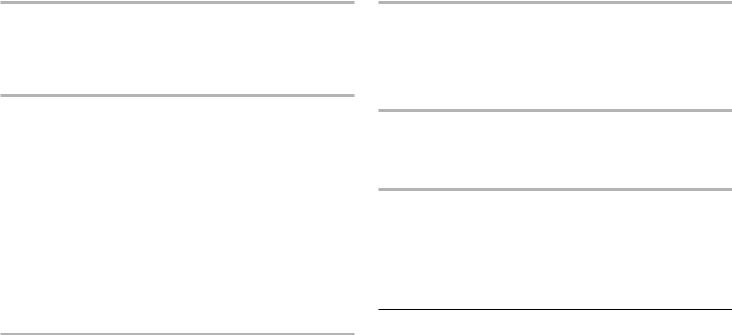
COIL ELEMENTS (on some models) Cleaning Method:
■■ Damp cloth:
Make sure control knobs are OFF and elements are cool. Do not clean or immerse in water. Soil will burn off when hot.
BURNER BOWLS (on some models)
Before removing or replacing coil elements and burner bowls, make sure they are cool and the control knobs are in the Off position.
Remove the coil element by pushing the edge of the coil element toward the receptacle. Lift it enough to clear the burner bowl. Pull the coil element straight away from the receptacle to remove. Lift out the burner bowl.
Cleaning Method: Chrome burner bowls
Wash frequently in warm, soapy water. (It is not recommended to wash chrome bowls in a dishwasher.) A mild abrasive cleaner and a plastic scrubber can be used to remove stubborn stains.
For heavily soiled bowls, place an ammonia-soaked paper towel on the stains and allow to soak for a short time, then gently scrub with a plastic scrubber.
SURFACE UNDER COOKTOP (on some models)
The coil cooktop will lift up to provide easy access for cleaning beneath. Lift the cooktop by both front corners until the support locks into place.
Cleaning Method:
■■ Glass cleaner, mild liquid cleaner, or nonabrasive scrubbing pad.
To avoid damage to the range, do not remove the cooktop.
OVEN RACKS
Cleaning Method:
■■ Steel-wool pad
■■ For racks that have discolored and are harder to slide,
a light coating of vegetable oil applied to the rack guides will help them slide.
STORAGE DRAWER (on some models)
Check that storage drawer is cool and empty before cleaning.
Cleaning Method:
■■ Mild detergent
OVEN CAVITY
Do not use oven cleaners on models with Self-Cleaning.
Food spills should be cleaned when oven cools. At high temperatures, foods react with porcelain and staining, etching, pitting, or faint white spots can result.
Cleaning Method:
■■ See the “Self-Cleaning Cycle” section.
Oven Light
The oven light is a standard 40 watt appliance bulb. Before replacing, make sure the oven and cooktop are cool and the control knobs are in the Off position.
To Replace:
1.Unplug range or disconnect power.
2.Turn the glass bulb cover in the back of the oven counterclockwise to remove.
3.Turn bulb counterclockwise to remove from socket.
4.Replace bulb, then bulb cover by turning clockwise.
5.Plug in range or reconnect power.
15

TROUBLESHOOTING
Try the solutions suggested here first in order to avoid the cost of an unnecessary service call.
Operation
PROBLEM |
POSSIBLE CAUSES |
SOLUTIONS |
Nothing will operate |
Power supply cord is unplugged. |
Plug into a grounded outlet. |
|
|
|
|
Household fuse is blown or a |
Replace the fuse or reset the circuit breaker. If the problem |
|
circuit breaker is tripped. |
continues, call an electrician. |
|
|
|
|
The control displays an F9 or F9 |
The electrical outlet in the home may be miswired. Contact a |
|
E0 error code. |
qualified electrician to verify the electrical supply. |
|
|
|
Cooktop will not operate |
The control knob is set incorrectly. |
Push in knob before turning to a setting. |
|
|
|
|
On ceramic glass models, the |
See the “Control Lock” keypad feature in the “Feature Guide.” |
|
oven Control Lockout is set. |
|
Excessive heat around |
Cookware that is not the proper |
cookware on cooktop |
size. |
Use cookware about the same size as the surface cooking area, element, or surface burner. Cookware should not extend more than 1/2" (1.3 cm) outside the cooking area.
Cooktop cooking results not |
Control knob set to incorrect |
See the “Cooktop Use” section. |
what expected |
heat level. |
|
|
Range is not level. |
Level the range. See the Installation Instructions. |
|
|
|
Cooktop element cycles on |
Element cycling due to a |
This is normal operation. The element may cycle on and off to |
and off on High setting |
temperature limiter. |
keep the cooktop from overheating. |
|
|
|
Oven will not operate |
Delay Start is set. |
See the “Electronic Oven Controls” section. |
|
|
|
|
Control lock is ON. |
Press and hold CONTROL LOCK for 3 seconds to unlock. |
|
|
|
|
Control is in Demo mode. |
Demo mode will deactivate all oven elements. See “Demo |
|
|
Mode” in the Electronic Oven Controls” section. |
|
|
|
|
Electronic oven control set |
See “Electronic Oven Controls” section. |
|
incorrectly. |
|
|
|
|
Cannot turn control lock on/ |
Hot Surface indicator light is ON. |
Wait for the cooktop surface to cool and try again when the Hot |
off |
|
Surface indicator light turns off. |
Oven temperature too high or |
Oven temperature needs |
See the “Oven Temperature Control” in the “Electronic Oven |
too low |
adjustment. |
Controls” section. |
|
|
|
Oven indicator lights flash |
Power to range is turned on or |
See “Control Display” in the “Electronic Oven Controls” section. |
|
restored. |
If the indicator light(s) keep flashing, call for service. See the |
|
|
“Warranty” for more information. |
|
|
|
Display shows messages |
Power failure. (Display shows |
Clear the display. On some models, reset the clock, if needed. |
|
flashing time.) |
See “Clock” keypad feature in the “Feature Guide” section. |
|
|
|
|
Error code. (Display shows letter |
Depending on your model, press CANCEL to clear the display. |
|
followed by number.) |
See “Control Display” in the “Electronic Oven Controls” section. |
|
|
If it reappears, call for service. See the “Warranty” for more |
|
|
information. |
Start needs to be pressed so a cycle can begin.
See the “Start” keypad feature in the “Feature Guide” section.
Self-Cleaning cycle will not |
The oven door is not closed. |
Make sure the oven door is fully closed. |
|
operate |
|
|
|
The Self-Cleaning function has |
See the “Self-Cleaning Cycle” section. |
||
|
|||
|
not been entered correctly. |
|
A Timed Cooking function has been entered.
See the “Cook Time” section.
The range is in Sabbath mode. |
See the “Sabbath Mode” section. |
|
|
16

PROBLEM |
POSSIBLE CAUSES |
SOLUTIONS |
|
|
|
|
|
Oven cooking results not |
Range is not level. |
Level the range. See the Installation Instructions. |
|
what expected |
|
|
|
The temperature set was |
Double-check the recipe in a reliable cookbook. |
||
|
|||
|
incorrect. |
|
|
|
|
|
|
|
Oven temperature is calibrated |
See “Oven Temperature Control” in the “Electronic Oven |
|
|
incorrectly. |
Controls” section. |
|
|
|
|
|
|
Oven was not preheated. |
See the “Baking and Roasting” section. |
|
|
|
|
|
|
Racks were positioned improperly. |
See the “Positioning Racks and Bakeware” section. |
|
|
|
|
|
|
Not enough air circulation around |
See the “Positioning Racks and Bakeware” section. |
|
|
bakeware. |
|
|
|
|
|
|
|
Batter distributed unevenly in pan. |
Check that batter is level in the pan. |
|
|
|
|
|
|
Darker browning of food caused |
Lower oven temperature 25°F (15°C) or move rack to a higher |
|
|
by dull or dark bakeware. |
position in the oven. |
|
|
|
|
|
|
Lighter browning of food |
Move rack to a lower position in the oven. |
|
|
caused by shiny or light colored |
|
|
|
bakeware. |
|
|
|
|
|
|
|
Incorrect length of cooking time |
Adjust cooking time. |
|
|
was used. |
|
|
|
|
|
|
|
Oven door was not closed. |
Be sure that the bakeware does not keep the door from closing. |
|
|
|
|
|
|
Oven door was opened during |
Oven peeking releases oven heat and can result in longer |
|
|
cooking. |
cooking times. |
|
|
|
|
|
|
Oven door was open for too long. |
If the oven door remains open for too long, the heating elements |
|
|
|
will shut off until the oven door is closed. |
|
|
|
|
|
|
Rack is too close to bake burner, |
Move rack to higher position in the oven. |
|
|
making baked items too brown on |
|
|
|
bottom. |
|
Pie crusts browning too quickly.
Use aluminum foil to cover the edge of the crust and/or reduce baking temperature.
Temperature scale was changed |
Foods are overdone or burnt even at low temperatures. See |
from Fahrenheit to Celsius. |
“Fahrenheit and Celsius” in the “Electronic Oven Controls” |
|
section. |
17

ASSISTANCE OR SERVICE
Before calling for assistance or service, please check “Troubleshooting.” It may save you the cost of a service call. If you still need help, check the contact information on the Certificate of Warranty that accompanies the product.
When calling, please know the purchase date and the complete model and serial number of your appliance. This information will help us to better respond to your request.
18
